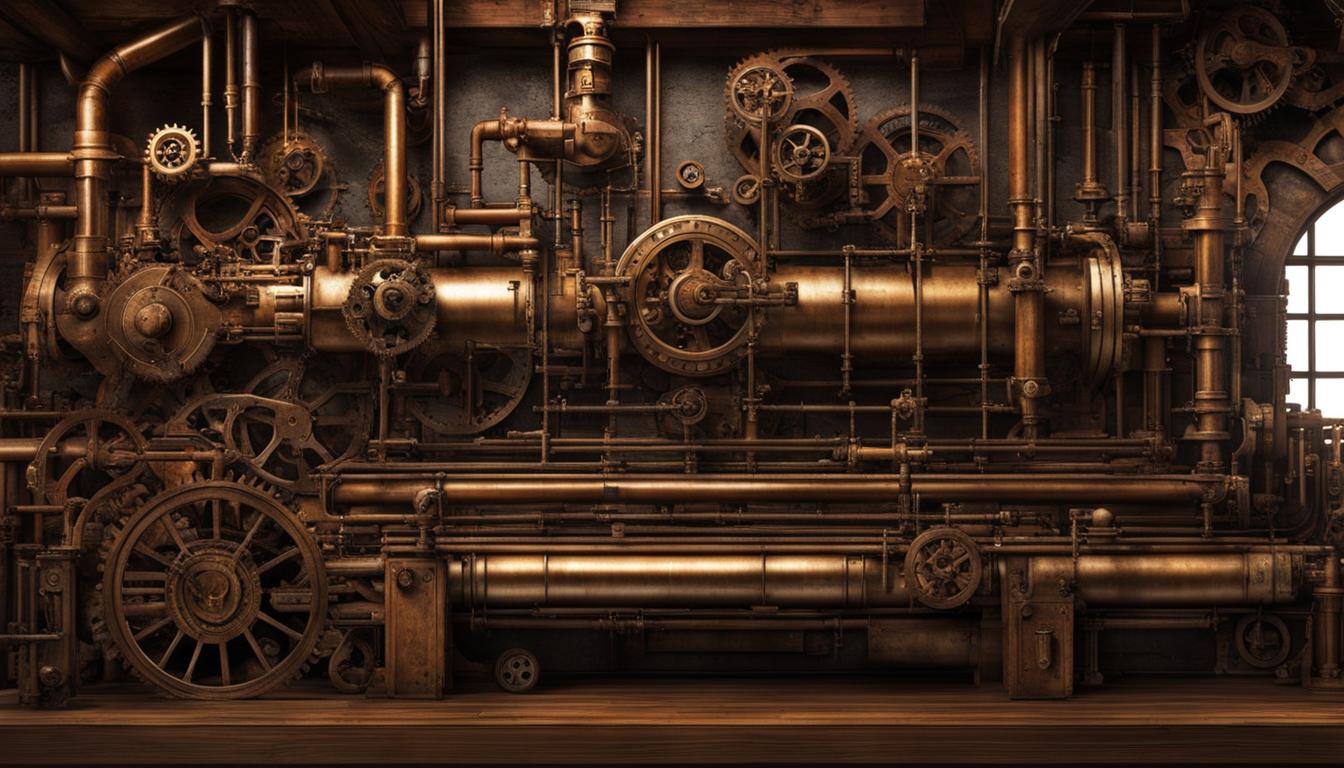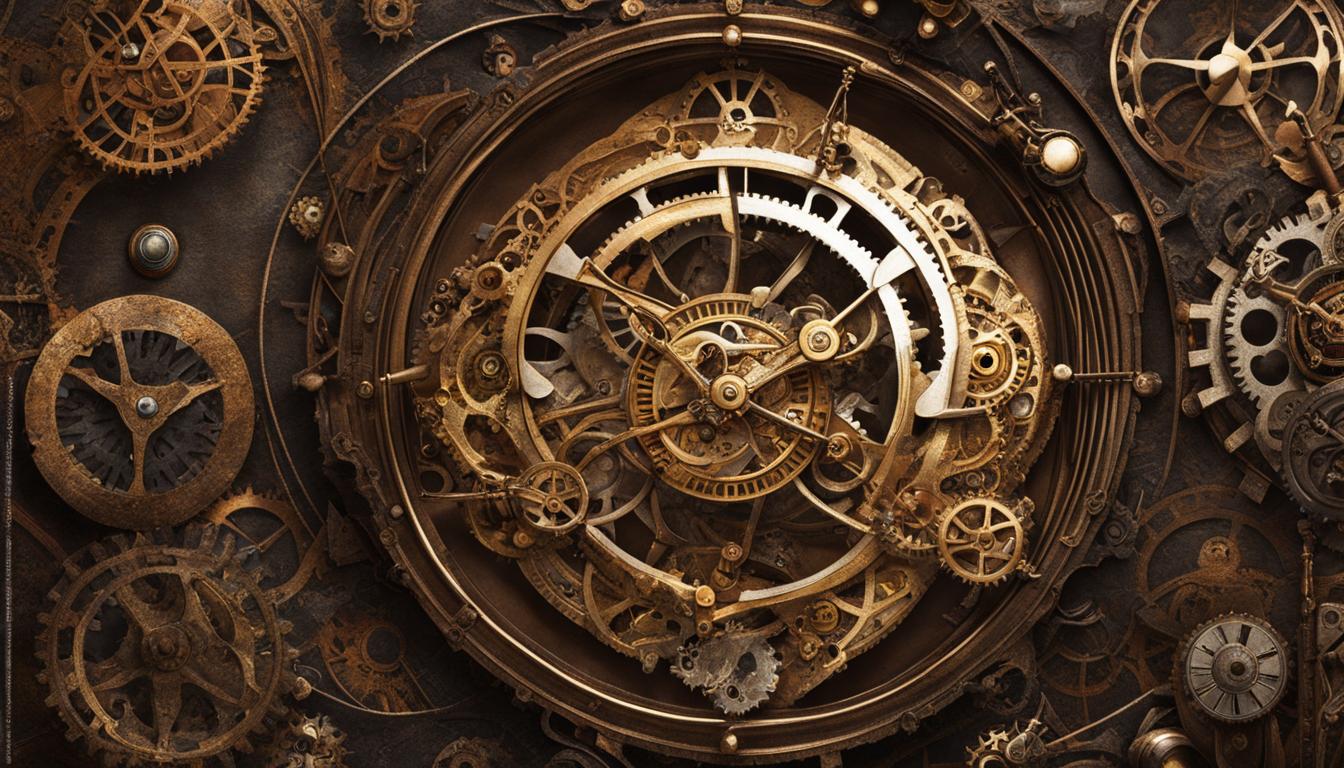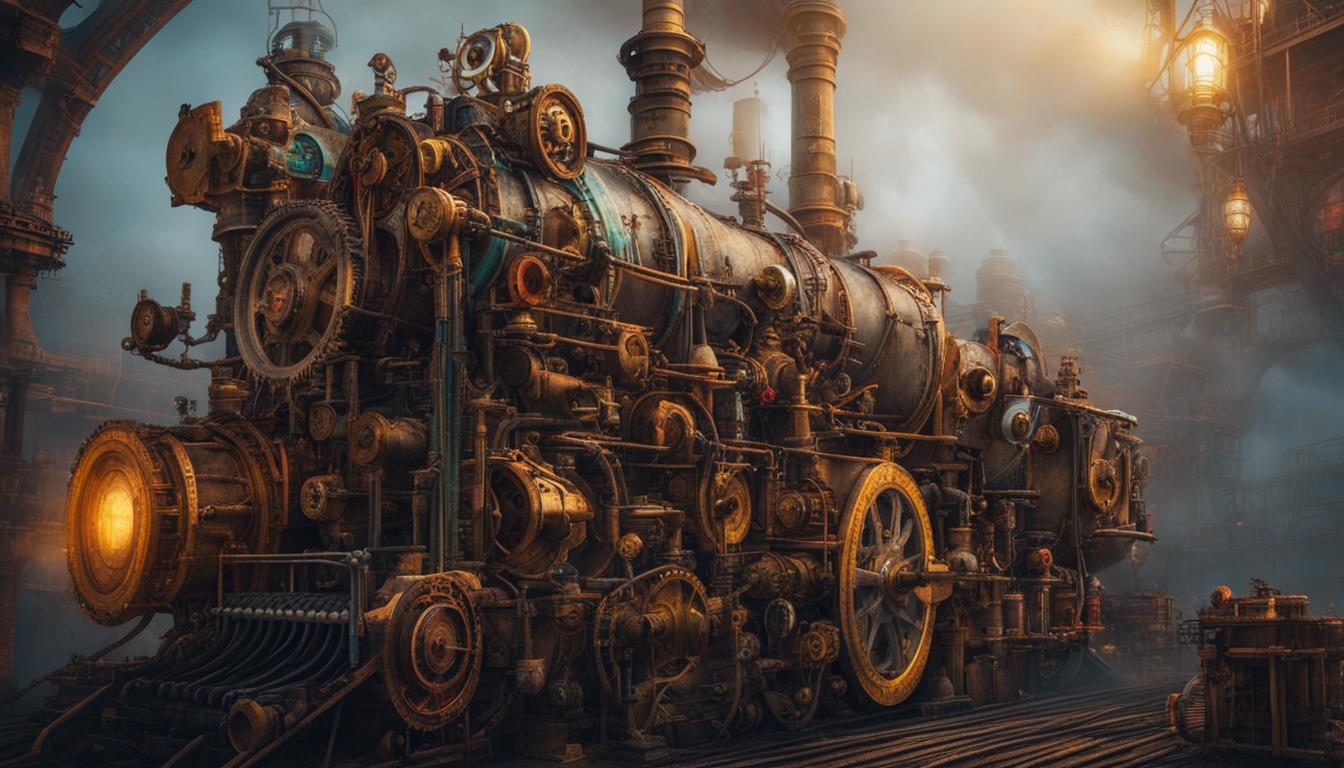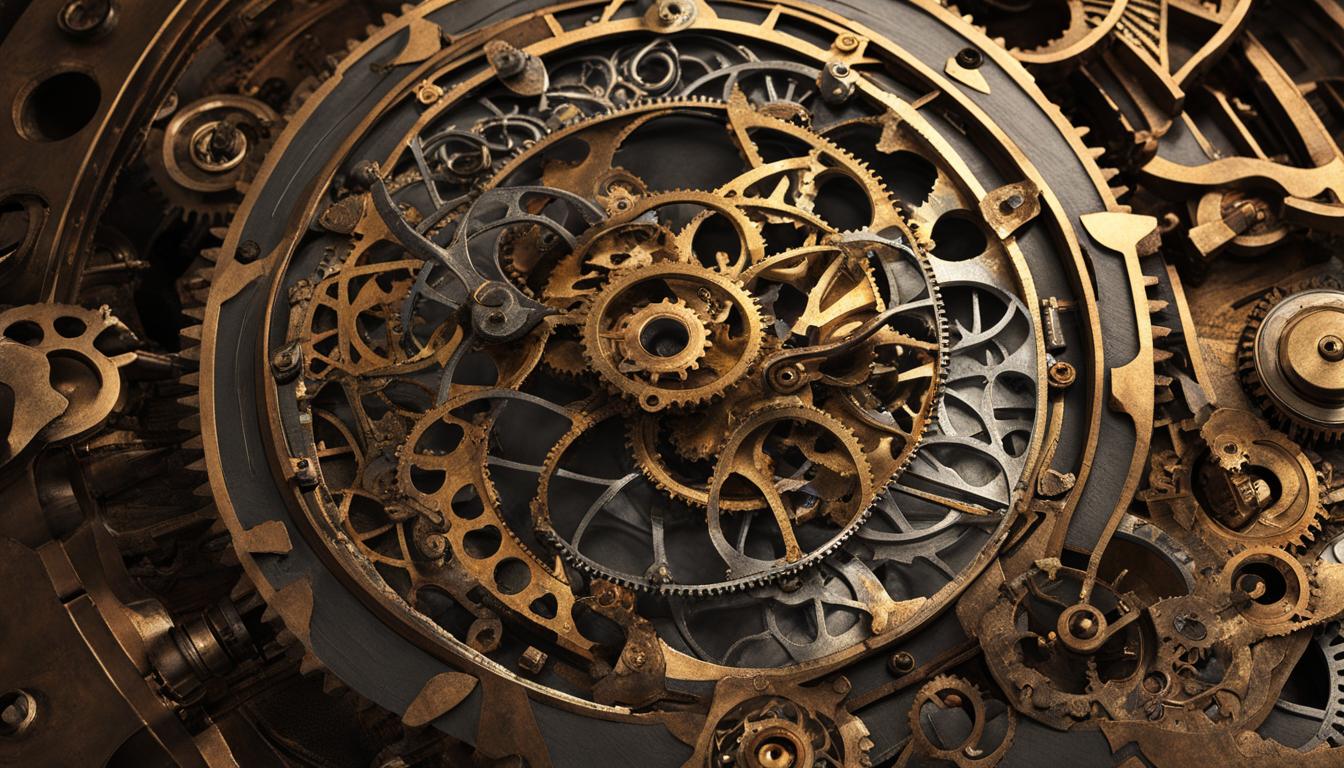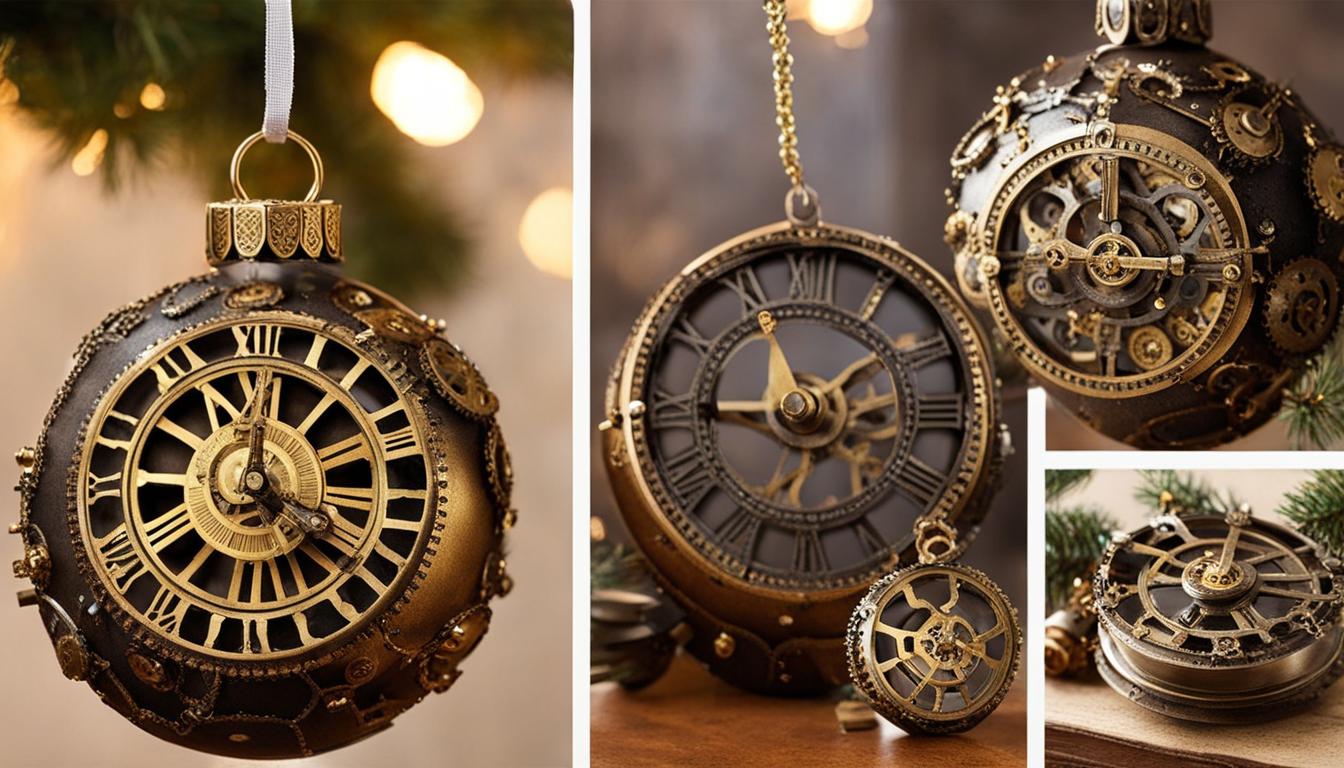Steampunk crafts are a fascinating blend of the past and present, combining elements from different eras to create truly remarkable pieces of art. One of the key aspects that adds depth and character to these creations is the use of metals and woods. By incorporating these materials into your steampunk DIY projects, you can bring a unique and captivating aesthetic to your designs.
From the industrial revolution to modern-day innovations, steampunk art draws inspiration from the fusion of past and present. This amalgamation of historical and contemporary elements results in eye-catching creations that capture the imagination.
Key Takeaways:
- The fusion of metals and woods adds depth and character to steampunk craft projects.
- Steampunk art draws inspiration from the industrial revolution and combines it with modern elements.
- Metalworking techniques such as welding, soldering, and riveting can be used to incorporate metals into steampunk crafts.
- Woodworking allows artists to shape, carve, and stain wood to complement the metal elements in their designs.
- The combination of metals and woods in mixed-media steampunk art creates visually intriguing and unique pieces.
Steampunk Art Inspiration: Fusion of Past and Present
Steampunk art is a captivating genre that draws inspiration from the industrial revolution and merges it with modern elements. This fusion of past and present creates visually stunning pieces that transport viewers to an alternate reality where Victorian aesthetics meet futuristic innovation.
The industrial revolution, characterized by the rise of machinery and steam power, provides a rich foundation for steampunk art. Artists embrace the icons of this era such as gears, cogs, and steam engines, infusing them with a sense of adventure and mystery. These elements evoke a sense of nostalgia for a time when progress and exploration were at the forefront of society.
“Steampunk art allows us to explore a world where history and imagination collide,” says renowned steampunk artist, Emily Westwood. “By combining the aesthetics of the past with modern ingenuity, we create eye-catching creations that challenge our perceptions and ignite our curiosity.”
Through the fusion of past and present, steampunk art sparks the imagination and invites viewers to ponder the possibilities of a world where technology and craftsmanship intertwine. By blending Victorian elegance with futuristic innovation, artists are able to push the boundaries of creativity and create truly unique works that captivate and inspire.
Table: Elements of Steampunk Art
| Iconic Symbols | Industrial Materials | Timeless Aesthetics |
|---|---|---|
| Gears | Metal | Victorian Elegance |
| Cogs | Brass | Machinery |
| Steam Engines | Copper | Mystery |
Steampunk art continues to inspire artists and enthusiasts alike with its fusion of past and present. By blending the industrial revolution with modern innovation, this genre pushes the boundaries of creativity and challenges our perceptions of what is possible. So, let your imagination soar and embark on a steampunk journey where history meets the future.
Incorporating Metals in Steampunk Crafts
The use of metals is an essential element in steampunk crafts, adding an industrial and futuristic touch to the creations. Metalworking techniques such as welding, soldering, and riveting allow artists to incorporate metals into their projects, resulting in visually striking and unique mixed-media steampunk items. By combining metals with other materials like woods, artists can achieve a harmonious balance and create captivating pieces that showcase the beauty of contrasting textures.
Incorporating metals in steampunk crafts offers endless possibilities for creativity and innovation. Whether it’s constructing a metal frame for a wooden sculpture or adding decorative metal accents to a jewelry piece, the combination of metalworking and woodworking techniques opens up a world of artistic exploration. DIY enthusiasts can experiment with different metals, such as brass, copper, and iron, to create their desired steampunk aesthetic.
Steampunk crafts provide a unique opportunity to push the boundaries of traditional crafting techniques and explore the fusion of different materials. By incorporating metals into their projects, artists can elevate their creations to new heights and create one-of-a-kind pieces that capture the essence of steampunk aesthetics.
Creating Mixed-Media Steampunk Art
The incorporation of metals in steampunk crafts often leads to the creation of mixed-media art, combining various materials to form intriguing and visually compelling pieces. The juxtaposition of metal and wood creates a sense of contrast that adds depth and complexity to the artworks. Artists can experiment with different techniques, such as metal etching, patina finishes, and wood staining, to achieve the desired look for their mixed-media steampunk creations.
From sculptures to home decor items, the fusion of metals and woods opens up a realm of possibilities for steampunk artists. By combining different materials, textures, and colors, artists can capture the essence of the steampunk genre and create pieces that spark the imagination of viewers. The intricate detailing and craftsmanship involved in mixed-media steampunk art make each piece a statement of artistic vision and creative expression.
Table: Comparison of Metalworking Techniques for Steampunk Crafts
| Technique | Description | Advantages | Disadvantages |
|---|---|---|---|
| Welding | Joining metals together using high heat and filler materials | Creates strong and durable bonds | Requires specialized equipment and training |
| Soldering | Connecting metals through the use of a lower melting point metal alloy | Relatively easy to learn and perform | May result in weaker connections compared to welding |
| Riveting | Using rivets to fasten metal components together | Provides a decorative element in addition to structural integrity | Requires precision in drilling and rivet placement |
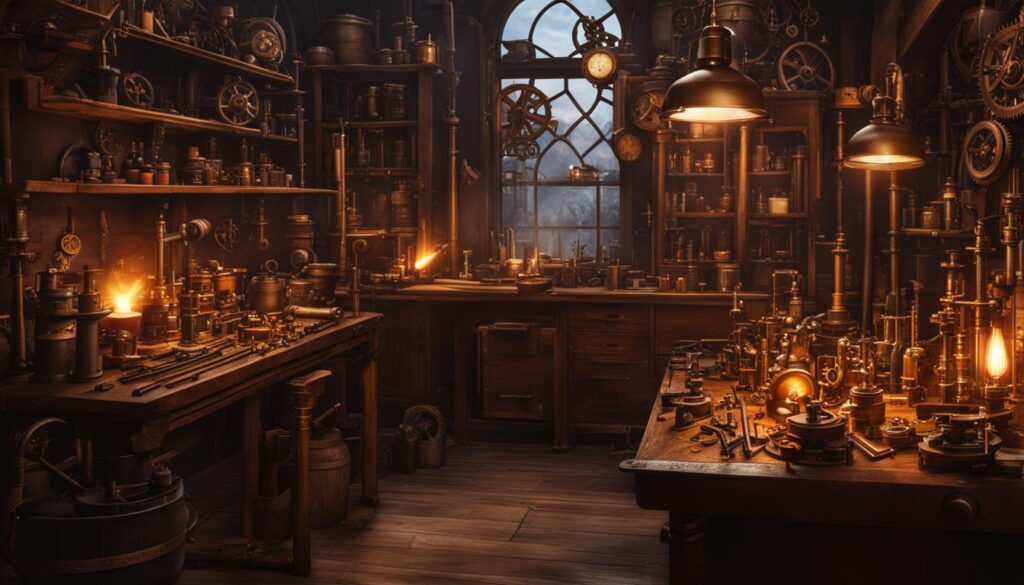
Working with Woods in Steampunk Designs
Woodworking is an essential aspect of steampunk crafts, adding warmth and natural beauty to the industrial aesthetic. Whether you’re a seasoned woodworker or new to the craft, incorporating wood into your steampunk designs can elevate your projects to a new level. From carving intricate details to staining for a rich finish, there are endless opportunities to explore. Let’s dive into the world of working with woods in steampunk designs.
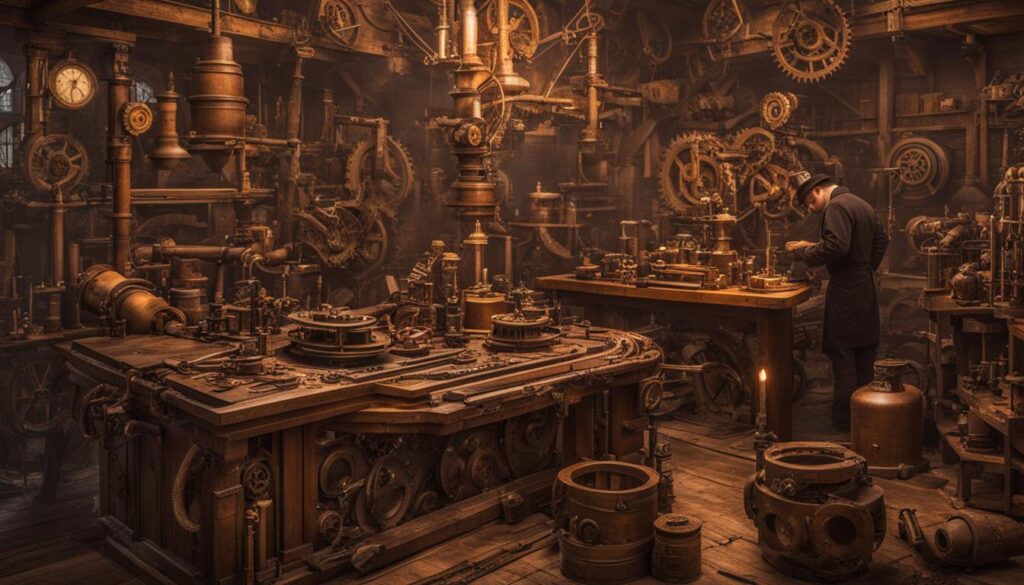
Carving and Shaping Wood
One of the most exciting aspects of working with wood in steampunk designs is the ability to carve and shape it into intricate patterns and designs. Whether you’re creating gears, cogs, or ornate embellishments, carving allows you to add unique details that bring your steampunk creations to life. With the right tools and techniques, you can achieve remarkable precision and create stunning focal points.
Staining and Finishing
To achieve a vintage and aged look for your wood pieces, staining and finishing are essential steps. Experiment with different wood stains to achieve the desired color and depth. Consider using darker stains like walnut or mahogany to create an antiqued effect. Once stained, applying a clear protective finish will not only preserve the wood but also add a professional look to your steampunk designs.
Combining Wood and Metal
The true magic of steampunk lies in the fusion of wood and metal elements. By combining these contrasting materials, you can create captivating pieces that are both rustic and futuristic. The juxtaposition of polished metals against the warm tones of wood adds depth and visual interest to your steampunk designs. Experiment with different ways to combine wood and metal, such as inlaid accents, riveted connections, or even integrated mechanisms.
Unleash Your Creativity
Working with woods in steampunk designs allows you to unleash your creativity and bring your imagination to life. Explore various techniques, experiment with different woods, and push the boundaries of what’s possible. From small accessories to larger furniture pieces, the possibilities are endless when it comes to incorporating wood into your steampunk crafts. Let your creativity soar and create one-of-a-kind masterpieces that blend the best of the past and the future.
Creating Mixed-Media Steampunk Art
Steampunk art embraces the fusion of metals and woods, allowing for the creation of captivating mixed-media pieces. This combination of materials adds depth, texture, and complexity to steampunk crafts, resulting in visually intriguing artworks. Whether you’re crafting sculptures, jewelry, or home decor, incorporating both metals and woods opens up a world of possibilities.
One popular technique in mixed-media steampunk art is the integration of metal and wood elements in DIY projects. By combining these materials, artists can achieve a harmonious blend of organic and industrial aesthetics. From intricate wooden carvings adorned with metal accents to clocks adorned with gears and brass, the juxtaposition of metals and woods brings a unique charm to steampunk creations.
“The fusion of metals and woods in steampunk art allows for the creation of pieces that tell a story. It’s like stepping into an alternate reality where the past meets the future, and the combination of materials reflects that narrative.” – Steampunk artist
In addition to the aesthetic appeal, the use of mixed-media techniques in steampunk art also adds an element of functionality. Metal components can serve as structural supports or functional gears, while woods provide a sturdy base or intricate detailing. The combination of these materials not only enhances the overall design but also adds practicality to the artwork.
When working with metals and woods in mixed-media steampunk art, it’s essential to consider the compatibility of the materials. Choose metals that complement the color and texture of the wood you’re using, and ensure proper adhesion between the two. Experiment with various techniques such as riveting, soldering, and epoxy bonding to achieve a seamless integration of metals and woods in your projects.
| Benefits of Creating Mixed-Media Steampunk Art | Examples |
|---|---|
| Enhanced depth and complexity in artwork | Steampunk-inspired jewelry combining brass gears and wooden pendants |
| Functional and practical designs | A wooden clock with visible gears made of metal |
| Unique storytelling through the fusion of materials | A mixed-media sculpture depicting an imaginary steampunk world |
Creating mixed-media steampunk art allows artists to unleash their creativity and explore the possibilities of combining metals and woods. It’s a way to bring the essence of the industrial revolution into the present, crafting works that are both visually striking and conceptually intriguing. Whether you’re a seasoned artist or a beginner, experimenting with metals and woods in your steampunk projects will undoubtedly ignite your imagination and result in one-of-a-kind creations.
Techniques for Achieving a Metallic Look on Wood
Creating a realistic metallic look on wood surfaces can elevate your steampunk craft projects to a whole new level. By using the right techniques, you can transform ordinary wood into a striking material that resembles metal. Whether you want to add a touch of industrial charm or create a futuristic vibe, here are some methods to achieve that metallic aesthetic:
1. Spray Painting with Metallic Finishes
If you want a quick and easy way to achieve a metallic look on wood, consider using spray paint with metallic finishes. Select a color that closely resembles the type of metal you want to emulate, such as silver or bronze. Start by cleaning and sanding the wood surface to ensure a smooth and even finish. Then, apply the spray paint in light, sweeping motions, holding the can about 8-12 inches away from the wood. To create depth and texture, you can layer different metallic colors or lightly dust the surface with black or brown paint for an aged appearance.
2. Sanding and Buffing
For a more textured and realistic metallic look, sanding and buffing can be highly effective. Begin by sanding the wood surface with fine-grit sandpaper to create a smooth base. Then, use a wire brush or steel wool to create scratches, dents, and other distressed effects. After creating the desired texture, apply metallic paint using a brush or sponge, making sure to work the paint into the crevices and textures. Once the paint is dry, use a soft cloth to buff the surface, emphasizing the raised areas and adding a subtle sheen.
3. Wood and Metal Finishes
If you prefer a more nuanced and authentic metallic look, you can use specialized wood and metal finishes. These finishes come in a variety of shades and are specifically designed to mimic the appearance of different metals. Apply the finish onto the wood surface using a brush, following the manufacturer’s instructions. These finishes typically require multiple coats and may involve the use of a protective topcoat to enhance durability. With the right wood and metal finishes, you can achieve a truly convincing metallic look on your steampunk craft projects.
Experimenting with these techniques will allow you to create wood surfaces that look like they are made of metal. Whether you’re working on a small jewelry box or a larger furniture piece, adding a metallic touch will undoubtedly enhance the overall steampunk aesthetic. So, go ahead and explore the world of wood and metal finishes to bring your steampunk creations to life.
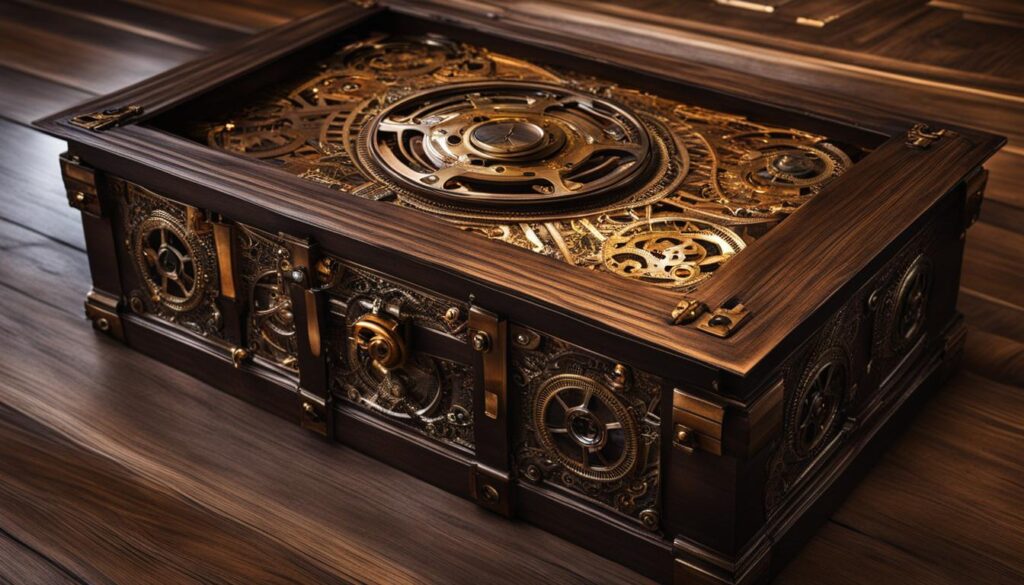
Steampunk Craft Tutorial: Making Wood Look Like Metal
Steampunk art thrives on the fusion of metals and woods, creating captivating designs that bring the past and present together. If you’re looking to add an industrial touch to your steampunk craft projects, learning how to make wood look like metal is a valuable technique to master. This step-by-step guide will walk you through the process, allowing you to achieve a realistic metallic finish on your wooden surfaces.
To start, gather the necessary materials for this tutorial. You’ll need:
- Wooden surface(s) to be transformed
- Metallic spray paint in your desired color(s)
- Painter’s tape
- Sandpaper or sanding block
- Clean cloth or tack cloth
- Clear sealer or varnish (optional)
Before you begin, prepare your workspace by covering it with a drop cloth or newspaper to protect it from overspray. Then, follow these steps:
- Step 1: Clean and sand the wooden surface(s) to remove any dirt, imperfections, or previous finishes. This provides a smooth and clean base for the metallic paint to adhere to.
- Step 2: Apply painter’s tape to any areas you want to keep wood or protect from the metallic paint. This will create clean lines and prevent overspray.
- Step 3: Shake the metallic spray paint can vigorously for about a minute to ensure proper mixing. Then, hold the can approximately 8-12 inches away from the wooden surface and apply an even coat of paint. Allow it to dry according to the paint manufacturer’s instructions.
- Step 4: Once the first coat is dry, apply additional coats as needed to achieve the desired metallic look. Remember to let each coat dry fully before applying the next one.
Once you’re satisfied with the metallic finish, remove the painter’s tape and let the paint cure completely. If desired, you can apply a clear sealer or varnish to protect the finish and enhance its durability. Now, you have successfully transformed wood into a stunning metal-like surface for your steampunk crafts.
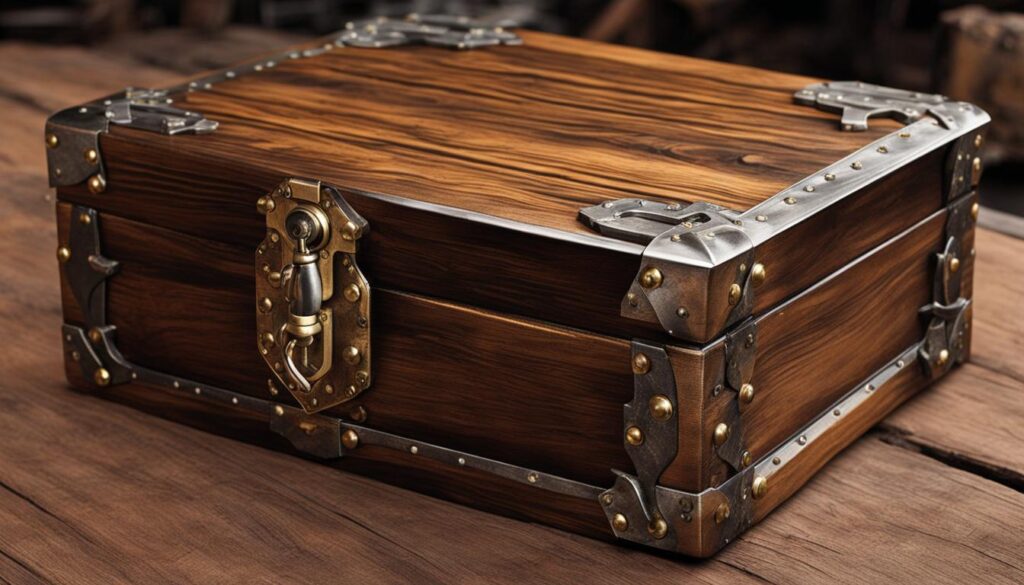
Experiment with different colors of metallic spray paint, sanding techniques, or even add weathering effects to achieve unique and aged-looking metal surfaces on wood. This tutorial provides a starting point, but feel free to explore and adapt the process to suit your artistic vision. Let your imagination run wild and infuse your steampunk crafts with the illusion of metal.
Conclusion
The fusion of metals and woods in steampunk crafts has revolutionized the art world, allowing artists to create mesmerizing and dynamic pieces that bridge the gap between the past and the present. By incorporating metals and woods into their projects, craftsmen can add depth, character, and an industrial aesthetic to their creations.
From intricate metalworking techniques like welding and riveting to the art of woodworking, steampunk artists have mastered the art of combining these materials to achieve a visually stunning and balanced steampunk aesthetic. The fusion of metals and woods opens up a world of possibilities, allowing for the creation of mixed-media art that captivates the imagination.
Whether it’s achieving a metallic look on wood surfaces or using wood to complement metal elements, the use of metals and woods in steampunk crafts adds a touch of mystery and elegance to any project. So, dive into the world of steampunk crafting today and let your creativity take flight!
FAQ
Can I use any type of metal in my steampunk craft projects?
Absolutely! Steampunk art allows for the use of various types of metals, such as brass, copper, and iron, to create unique and eye-catching pieces.
How can I incorporate metals into my steampunk crafts?
Metalworking techniques like welding, soldering, and riveting can be used to incorporate metals into your steampunk projects. You can create mixed-media pieces that combine metals with other materials like wood.
Is woodworking important in steampunk art?
Woodworking is a crucial aspect of steampunk crafts. Artists can shape and stain wood to create intricate designs that complement the metal elements in their projects, adding depth and character to their steampunk creations.
How does the fusion of metals and woods enhance steampunk designs?
The combination of metals and woods in steampunk crafts offers endless possibilities for creating unique and visually stunning pieces. It adds a layer of complexity and depth to the overall aesthetic, making the creations more captivating.
How can I make wood look like metal in my steampunk craft projects?
Achieving a metallic look on wood can be challenging but rewarding. Techniques such as spray painting with metallic finishes, sanding, and buffing can be employed to create a realistic and convincing metallic appearance on wood surfaces.
Is there a tutorial available for making wood look like metal in steampunk crafts?
Yes! In our tutorial, we will guide you through the process of making wood look like metal for your steampunk craft projects. Follow along step by step to bring an industrial touch to your creations.

